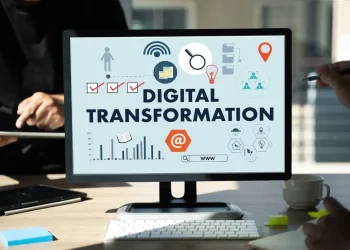In a time when digital tools have changed every part of our lives, this change has also affected governments around the world. The integration of IT into governance systems and the emergence of governmental platforms has revolutionized public sector management. In order to understand their significance in the age of digital governance, this study delves deeply into the worlds of IT Governance and Governmental Platforms.
Table of Contents
2. Understanding IT Governance
IT is a key part of business growth in today’s digital world. IT governance is the glue that holds IT resources and projects together so that they support business goals and give value. IT governance optimizes resources, controls risks, and encourages new ideas by setting up a system for making decisions and holding people accountable.
2.1. The Importance of IT Governance in Business
IT governance is a cornerstone in today’s digital enterprises. Here’s why:
- Strategic Alignment: IT governance ensures that IT investments are in sync with business goals. It aligns IT strategy with business strategy, keeping organizations on track to reach their objectives.
- Risk Management: It helps manage risk by setting standards for IT system security, disaster recovery, and data integrity.
- Resource Optimization: By promoting transparency and accountability, IT governance assists businesses in optimizing their IT resources and making well-informed IT investment decisions.
2.2. Key Principles of IT Governance
Several core principles guide effective IT governance:
- Business Alignment: IT governance should be aligned with the business strategy, ensuring IT initiatives support organizational objectives.
- Transparency and Accountability: Good government helps make decision-making more transparent and accountable.
- Risk Management: It should manage risks related to IT investments and operations.
- Value Demonstration: IT governance should measure and showcase the value of IT by tying IT performance to business performance.
2.3. IT Governance Frameworks
IT governance is the method that a company uses to direct and control its IT portfolio. It outlines the decision-making rights and accountability to encourage desirable behavior in using IT.
Particularly in the public sector, IT governance ensures that IT investments align with strategic objectives and deliver value while managing risks.
Several frameworks provide guidance for implementing IT governance. Among these are COBIT, ITIL, and ISO/IEC 38500. They offer:
- Best Practices: These frameworks provide best practices for aligning IT strategy with business strategy.
- Guidelines and Tools: They offer guidelines and tools for managing IT risks and measuring IT performance.
- Adaptability: The choice of framework depends on the organization’s specific context, needs, and objectives.
Regardless of the specific framework chosen, the ultimate goal is to integrate IT governance with overall corporate governance effectively and efficiently, supporting business objectives.
3. The Emergence of Governmental Platforms
In an era in which digital technologies are revolutionizing how we communicate and conduct business, governments around the world are staying caught up. Governmental platforms built on digital technology have emerged as critical tools for delivering public services. These platforms enable a unified, user-centric approach to service provision, enhancing transparency, accountability, and citizen engagement.
4. Challenges of IT Governance in Government
Although there are many advantages to using government platforms, achieving efficient IT governance in government organizations is challenging. These organizations frequently face bureaucracy, which can impede decision-making. Privacy and security are of the utmost importance because governments hold private information that needs to be kept safe.
Resource limitations can also be a problem, especially for governments with limited money or expert skills. Lastly, the nature of public service requires a high level of openness and accountability, which makes IT governance in this sector even more critical.
5. Future Prospects: Digital Government and Citizen Engagement
Looking ahead, it’s clear that technology is the future of government. As technology improves, it will always change how government services are given and how people interact with their government. Artificial intelligence (AI), the Internet of Things (IoT), big data analytics, and blockchain are just some of the disruptive technologies that will continue to change how government systems and IT governance are run.
In this changing world, the rules and structures of IT governance will need to change and adapt to make sure that these technologies are used efficiently and effectively, to keep the public’s trust and safety, and to make it easier for citizens to get involved. The future holds exciting possibilities for digital government and IT governance – a future where technology enhances public service delivery and citizen participation.
6. Important IT Decisions: The Categories
IT decisions in an organization can be divided into different categories, each representing a distinct aspect of IT management. These categories can be adjusted based on an organization’s unique needs, but the following list provides a general idea of the different types of IT decisions:
- Strategic Decisions: These include high-level, long-term decisions about the role of IT in the organization. Examples could be decisions regarding the adoption of a digital transformation strategy, moving to cloud computing, or setting up a new data center.
- IT Infrastructure Decisions: Decisions concerning the IT infrastructure, like the selection of hardware, network architecture, software platforms, and data management systems, fall into this category.
- IT Investment and Budgeting Decisions: These decisions pertain to the allocation of financial resources for various IT projects, hardware or software acquisitions, and other IT expenditures.
- IT Security and Risk Management Decisions: This category includes decisions related to managing cybersecurity threats, implementing data protection measures, compliance with regulations, and disaster recovery planning.
- IT Human Resources Decisions involve recruiting, training, and managing IT personnel within the organization. This could also involve decisions about outsourcing certain IT functions.
- IT Project Management Decisions: Decisions about the initiation, planning, execution, control, and closure of IT projects fall into this category. This could involve choosing methodologies, tools, or project management frameworks.
- IT Governance Decisions: These decisions concern the overall management of IT within the organization, including establishing processes, defining roles and responsibilities, and ensuring alignment between IT and business objectives.
- IT Vendor and Outsourcing Decisions: This category includes decisions related to selecting IT vendors, negotiating contracts, and managing relationships with these external entities.
Understanding these categories of IT decisions can help effectively manage the IT function, align IT with business objectives, and maximize the value derived from IT investments.
7. Six Archetypal Approaches to IT Decision Making
Organizations employ a variety of approaches to IT decision-making, which range from highly centralized to highly decentralized. Here are six archetypal approaches:
Business Monarchy: This is a centralized approach where IT decisions are made by business executives or a small group of business leaders. It is typically seen in organizations with strong business-driven strategies. The C-suite, including the CEO and top executives, makes major IT decisions.
- IT Monarchy: In this approach, IT decisions are made centrally by IT executives. This is common in organizations highly dependent on their IT for their operations, such as tech companies or firms with a strong focus on data security.
- Feudal: This is a highly decentralized approach where individual business units or functions make their own IT decisions. Each department or division has control over its IT investments and decisions, often leading to a variety of systems and technologies across the organization.
- Federal: This approach combines central and decentralized decision-making. Strategic IT decisions are made centrally, while individual business units make operational decisions. This model often includes a central IT governance body that creates and enforces IT policies.
- Duopoly: IT decisions are made collaboratively by both business and IT executives. This ensures that IT decisions align with the business strategy and understand the requirements.
- Anarchy: This highly decentralized approach has no formal structure for IT decision-making. Instead, decisions are made independently by individual users or small teams. This approach is rare but can be found in startups or small businesses with a highly entrepreneurial culture.
Each of these approaches has its advantages and disadvantages, and the best approach depends on an organization’s size, culture, industry, and strategic objectives.
8. Government as a Platform: A Closer Look
“Government as a Platform” (GaaP) is a term that refers to the strategic use of technology by governments to provide services, engage citizens, and streamline operations.
Instead of each government agency creating isolated IT solutions for different needs, GaaP aims to build a common, reusable, and interoperable infrastructure that can be used across the entire government. This approach allows for the efficient use of resources, standardization, and interoperability.
Here are some key aspects of the Government as a Platform approach:
- Shared Infrastructure: Different government departments can build services that work seamlessly together using a shared digital infrastructure. This could include common technologies for identity verification, payment processing, or data sharing.
- Open Standards and Interoperability: Government as a Platform encourages the use of open standards that allow different systems to work together. This facilitates data sharing and communication between different government systems.
- User-Centric Services: The platform approach puts the needs of citizens at the center. By understanding the needs and behaviors of the users, governments can design services that are easy to use and accessible.
- Open Data: Government as a Platform also involves making government data open and accessible while ensuring privacy and security. This transparency can improve trust and enable innovation.
- Ecosystem of Services: By providing a platform, the government can enable third parties, such as businesses or non-profits, to build additional services. This can create a rich ecosystem of services that benefits citizens.
- Agility and Scalability: Government platforms are typically designed to be scalable and flexible, allowing for quick adjustments in response to new requirements or changes in demand.
Examples of the Government as a Platform approach can be seen in the UK’s Government Digital Service or the US Federal Government’s digitalgov.gov. These platforms offer resources, tools, and guidelines that help government agencies build effective digital services.
9. Challenges and Roadblocks: Why Progress Can Be Slow
Despite the significant advantages of an open government model, the transition can often be slow due to several factors:
- Managing Complexity: It can be difficult to implement only legally permissible modifications while providing tools to correct errors. Balancing efficiency and compliance requires careful planning and a well-structured system.
- Data Model Standardization: Standardising data models across different systems and organizations is a huge job. With standardization, data sharing, interoperability, and collaborative work have become more accessible.
- Security Concerns: Secure access to sensitive data is a significant hurdle. Agencies must develop robust security mechanisms to protect data while allowing legitimate access.
- Governance Issues: Determining which entities should be responsible for various tasks is critical. Clear roles and responsibilities must be defined to avoid confusion and ensure accountability.
- Costly and Specialized Testing: Testing new systems for functionality, security, and scalability can be expensive. Moreover, it often requires specialized competencies that may be lacking within the agency.
- Skill Gaps: Open government initiatives require specific technical skills and the ability to understand and apply this knowledge from a functional perspective. This combination may be lacking in many agencies.
- Stakeholder Confidence: Lastly, key stakeholders may be unwilling to invest in open government initiatives due to concerns about ROI, potential risks, or simply a lack of understanding of the benefits.
Addressing these challenges requires strategic planning, adequate resources, and a commitment to developing the necessary skills and competencies within the agency. Despite the challenges, the potential benefits of open government initiatives are significant, making the effort worthwhile.
Wrapping Up
The digital age necessitates a systematic and disciplined approach to IT management in government. When combined with the wise use of government platforms, effective IT governance can pave the path for a more efficient, transparent, and citizen-centric public sector. As technologies evolve, so will the strategies and platforms for managing and delivering public services.
Understanding these dynamics is crucial for IT professionals, policymakers, public administrators, and citizens. As we move forward, the collaborative efforts of all stakeholders will be essential in leveraging the potential of IT to transform the way our governments function.
Further Reading and References
🚀 Before You Go:
- 👏 Found this guide helpful? Give it a like!
- 💬 Got thoughts? Share your insights!
- 📤 Know someone who needs this? Share the post!
- 🌟 Your support keeps us going!
💻 Level up with the latest tech trends, tutorials, and tips - Straight to your inbox – no fluff, just value!
















